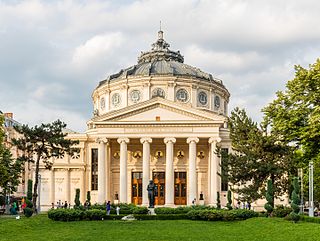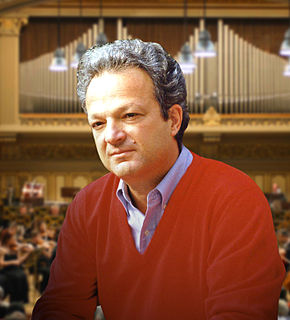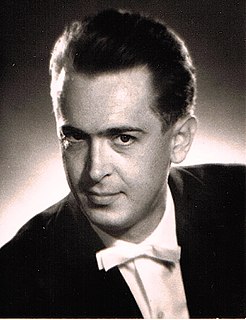Constantin-Nicolae Silvestri was a Romanian conductor and composer.

George Enescu, known in France as Georges Enesco, was a Romanian composer, violinist, conductor and teacher. Regarded as one of the greatest musicians in Romanian history, Enescu is featured on the Romanian five lei.

The Romanian Athenaeum is a concert hall in the center of Bucharest, Romania and a landmark of the Romanian capital city. Opened in 1888, the ornate, domed, circular building is the city's most prestigious concert hall and home of the "George Enescu" Philharmonic and of the George Enescu Festival.

Ion Voicu was a Romanian violinist and orchestral conductor of Romani ethnicity. In 1969 he founded the award-winning Bucharest Chamber Orchestra, which is now conducted by his son Mădălin Voicu.

The Seoul Philharmonic Orchestra (SPO) is one of the prominent orchestras in South Korea which is based in Seoul. Founded in 1948, it is one of the oldest orchestras in South Korea. Its first foreign tour came on a 1965 trip to Japan, followed by performances in Southeast Asia in 1977, the United States in 1982, 1986, and 1996, a 1988 tour of Europe before the Seoul Olympics that year, and a 1997 performance in Beijing. The Philharmonic is an incorporated foundation since 2005.
Christian Badea is a Romanian-American opera and symphonic conductor.

Symphony No. 1, Op. 13, in E♭ by the Romanian composer George Enescu reflects the composer's training in both Vienna and Paris. In the former location he studied the Brahmsian tradition with Robert Fuchs, and in the latter the French tradition with Jules Massenet and Gabriel Fauré.

Walter Hilgers is a German tuba player and conductor. He performs worldwide as orchestral musician, soloist, academic music teacher, arranger and conductor.

The Moldova Philharmonic Orchestra is a Romanian symphony orchestra located in Iași, Romania. The name "Moldova" in the title refers to the historical region of Moldavia.

The George Enescu Festival, held in honor of the celebrated Romanian composer George Enescu, is the biggest classical music festival and classical international competition held in Romania and one of the biggest in Eastern Europe. Enescu's close associate George Georgescu organized the first festival in 1958; highlights included a performance of Bach's Concerto for Two Violins with Yehudi Menuhin and David Oistrakh as soloists and a staging of Enescu's sole opera, Œdipe, with Constantin Silvestri conducting.
Ion Marin is a Romanian-Austrian conductor. He is internationally renowned both in operatic and symphonic domains.

George Georgescu was a Romanian conductor. The moving force behind the Bucharest Philharmonic Orchestra for decades beginning shortly after World War I, a protégé of Artur Nikisch and a close associate of George Enescu, he received honors from the French and communist Romanian governments and lived to make recordings in the stereo era.
Cristina Iordachescu is a Romanian mezzo-soprano and pianist. She was born October 8, 1966, in Bucharest.
Noam Zur is an Israeli conductor. the New Chief conductor in Argentinian State orchestra of Salta
Since July 2015 he is the artistic director of the Tino Pattiera Opera Arias Festival in Dubrovnik, Croatia and from 2016 the Principal Guest Conductor of the Dubrovnik Symphony Orchestra
Between 2011 and 2015 he was the principal conductor and artistic associate of the Kammerphilharmonie Frankfurt.

The two Romanian Rhapsodies, Op. 11, for orchestra, are George Enescu's best-known compositions. They were written in 1901, and first performed together in 1903. The two rhapsodies, and particularly the first, have long held a permanent place in the repertory of every major orchestra. They employ elements of lăutărească music, vivid Romanian rhythms, and an air of spontaneity. They exhibit exotic modal coloring, with some scales having 'mobile' thirds, sixths or sevenths, creating a shifting major/minor atmosphere, one of the characteristics of Romanian music. They also incorporate some material found in the later drafts of Enescu's Poème roumaine, Op. 1.
Karolos Trikolidis was a conductor of Greek-Austrian origin.

Vladimir (Vlad) Conta is a Romanian conductor and pianist with an international career spanning 30 years. He was the Principal Conductor of the Regina Symphony Orchestra in Canada. He has been a Principal Conductor at the Romanian National Opera, Bucharest, since 2001.

Emil Simon was a Romanian conductor and composer.

Alfonso Maribona is an orchestra conductor, pianist, composer and arranger. Maribona was born in Bilbao, and finished his piano and chamber music qualifications at the Royal Conservatory of Music in Madrid, at the same time winning First Prize at the End of Postgraduate Course by a unanimous decision. In 1982 he obtained Second Prize at the National Piano Competition, then in 1985 he was awarded First Prize at the same competition. In 1991 he won First Prize at the "Ciudad de Manresa" National Chamber Music Competition, and in the same year, by a unanimous jury verdict, he gained First Prize at the National Chamber Music Competition of Spain.

The Symphony No. 3, Op. 21, in C major is a large-scale orchestral-vocal composition by the Romanian composer George Enescu, written in 1916–18.














